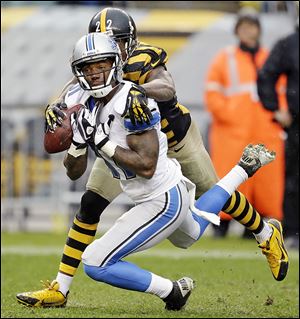
DETROIT LIONS
Schwartz defends fake field goal call
Failure sparked late Steelers’ run
11/18/2013
Detroit's Kevin Ogletree can't hang onto a pass as Pittsburgh's William Gay defends. The Lions fell to 6-4 and into a first-place tie with Chicago.
ALLEN PARK, Mich. — Jim Schwartz is standing by his decision to call a fake field goal in the fourth quarter at Pittsburgh.
In fact, the Detroit coach sounds ready to do it again if the right situation presents itself.
"We got the look that we wanted, we thought it was there, we didn't execute it great," Schwartz said Monday. "If we think there's something there special teams-wise, next week, not going to be afraid to call it."
The Lions were up by four early in the final quarter against the Steelers on Sunday, but their fake deep in Pittsburgh territory didn't work.
Detroit collapsed after that, allowing two touchdowns and losing 37-27, falling back into a first-place tie with Chicago in the NFC North.
A day later, the fake field goal was still a big topic around Detroit. The Lions were up 27-23 when kicker David Akers came out for what looked like a 27-yard field goal attempt.
Rookie punter Sam Martin then took the snap and tried to find room over the right side, needing five yards for a first down. He didn't quite get there, and he ended up fumbling the ball away anyway.
"If we were successful in that situation, and we go up 11 right there, I know what you guys would write," Schwartz said. "You guys would write: 'It's a different attitude, Lions are going for the win, they're not trying to just be settling for field goals.'"
It was a move with obvious risks and rewards. Keith Goldner, chief analyst at numberFire.com, estimates that the Lions needed about a 66 percent chance of converting the fake for it to make mathematical sense — although he cautioned that every situation is unique.
"You can't go straight by the numbers, but they are a good starting point and should definitely be incorporated into decision-making analysis," Goldner said in an email.
Even after the fake failed, the Lions still had the Steelers pinned back deep in their own territory. A number of other things had to go wrong for this game to slip away.
After stopping the fake, Pittsburgh drove 97 yards in 16 plays, taking the lead with 4:46 remaining. Suddenly, Detroit was behind for the first time in the second half. Then Matthew Stafford threw an interception, and the Steelers added an insurance TD.
Stafford threw for 362 yards and two touchdowns but struggled along with the rest of the Lions in the second half. Calvin Johnson had six catches for 179 yards in the first half — then didn't catch a pass in the second.
"We weren't going away from him. We wanted to keep throwing," Schwartz said. "We threw the ball to him in two critical situations. One was a third-and-goal, and they doubled him as we expected. We still threw the ball to him, he wasn't able to get it down. And another one was on the ball we got intercepted late in the game."
Detroit looked unstoppable at times in the second quarter, when the Lions scored all 27 of their points. But Pittsburgh regrouped.
Now the Lions (6-4) are even with Chicago again, although Detroit swept the Bears this season. The Lions host Tampa Bay this weekend, with a chance to put all the questions from the loss to Pittsburgh behind them.
"We're not aggressive just to be aggressive or conservative for the sake of being conservative. It's all within the game plan," Schwartz said. "We're going to make the decisions based on what we see on film and looks we get on offense, defense and special teams. We'll do what we think is best to win the game."